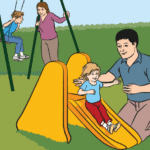If you are wondering how you can help a loved one, in the article below, you will find some very important tips.
How can you tell if your loved one is addicted?
What most often starts to worry about the behavior of our partner is avoiding spending time together, extended hours at work, closing in the so-called own world (e.g. games, computer, social media), constant fatigue, irritation, reluctance to talk, avoiding physical proximity.
It happens that we start to observe that a loved one most willingly spends time with a drink or a glass of wine. Or when we go to a meeting with friends, she loses touch with reality, explaining that sometimes she needs to rest and “reset”.
Often in a situation where access to his “favorite” activity is difficult, he becomes nervous or unpleasant.
If this activity is a repetitive behavior for some time (e.g. a computer game, other activities in the online world, alcohol during an evening session), we start to wonder if our partner has fallen into the trap of addiction.
What we notice at the beginning is the distance in our relationship and the difficulty of establishing an understanding.
You can become addicted to many different substances or activities: alcohol, drugs, shopping, sex, pornography, computer games, using the telephone, gambling, diets, physical activity and many others.
Find help at Cornerstone of Southern California
Diagnosis of addict’s behavior
- Strong need / strong desire / compulsion / to drink, take drugs. The strong thought of wanting to drink alcohol, have sex or play a game.
- Loss of control. We talk about losing control when a person engages in behavior that he would not undertake when sober. For example, an alcohol dependent person can make the decision to drive a car, and being sober, declares that he would never do so. We also talk about losing control when drinking one glass of wine entails the desire to drink another. Watching a single pornographic movie ends up watching pornography for hours or hours. And it’s hard to say “enough”, “enough”. “Red lamp does not come on.”
- Change in the tolerance dose. We talk about a dose change when we observe that our body needs more alcohol than before, or on the contrary, a smaller amount of alcohol brings a quick effect.
- Abstinence symptoms, i.e. nervousness, irritability, often physical pain, sweating and others. The body reacts in this way to the lack of substances in the body or when access to a given activity is difficult, e.g. to a computer, the Internet (in the case of computer / Internet addiction).
Neglecting other alternative pleasures. There is successive resignation from other activities. No desire to go for a walk, go out, or exercise, etc.
Continue behavior related to addiction (e.g. drinking alcohol) regardless of the harm that has started to occur. The damage can be physical, emotional. Damage to relationships with relatives or people in general, financial losses, worse performance of duties, problems at work.
Difficulties in treating addiction
Lack of or low motivation – what does it result from?
Addicts do not see their problem for a long time. Most often it is a close person, sometimes an acquaintance or a doctor who notices the problem first. The question often becomes: what needs to happen for you to see that you have a problem? The border is very individual and often the road to it is long. Why is this happening?
Addicted people have difficulty confronting their own addiction, because this is the specificity of this disease. The mechanism of illusion and denial – which develops gradually and maintains addiction – makes it impossible to see that “I drink too much”, “too much”, “that I do not see any harm in my life – although I can barely breathe the next day”, “I justify situations when I get drunk again at a party – explaining that I am tired, overworked, stressed and that it happens to everyone ”,“ everyone drinks ”.
Motivation often changes dynamically only when something happens that is difficult to justify, explain, explain – that is, when the boundary is clear and severe as a consequence. For example, when someone loses their job because of drinking, or when the police withdraw their driver’s license during a routine check, or more drastically, when one day, after returning home, it turns out that the wife and children have moved out.
Fortunately, research shows that the end result of therapy, when it occurs, is not dependent on the initial motivation to change.
In addictions, the initial motivation is usually external. Only with time does internal motivation build (resulting from the needs of the person undertaking work on changing their own functioning).
Currently, motivation is treated as a dynamic process in which the addict is responsible for the change. But an important role in building and strengthening motivation may be played by the accompanying persons in the process of change (including relatives, friends, family, specialists).
The motivation process depends, inter alia, on the life situation of a person, the conditions in which he lives, the circumstances, difficulties he encounters, and the reasons that may induce him to change. That is, the easiest way is what loses and what gains by making changes in its current functioning.
Keep in mind that addiction has a function. The change causes the loss of this function. It is most often used to regulate emotions, i.e. it helps to deal with anger, sadness, anxiety, stress, tension, guilt or shame and many other difficult emotions.
For change to occur, the gains of the change must be greater than the gains of maintaining the addiction function.
What strengthens addiction and at the same time makes it difficult for the addicted person to recognize the problem are the mechanisms that maintain the addiction. Disarming them will help in building your motivation. It is particularly important to recognize and extinguish the mechanism of illusions and denials.
This mechanism builds an atmosphere of fantasy and illusion and causes cognitive distortions, which on the one hand “protect” the addicted person from reality. On the other hand, they make it difficult for her to face reality, that is, to recognize the problem and deal with it constructively.













